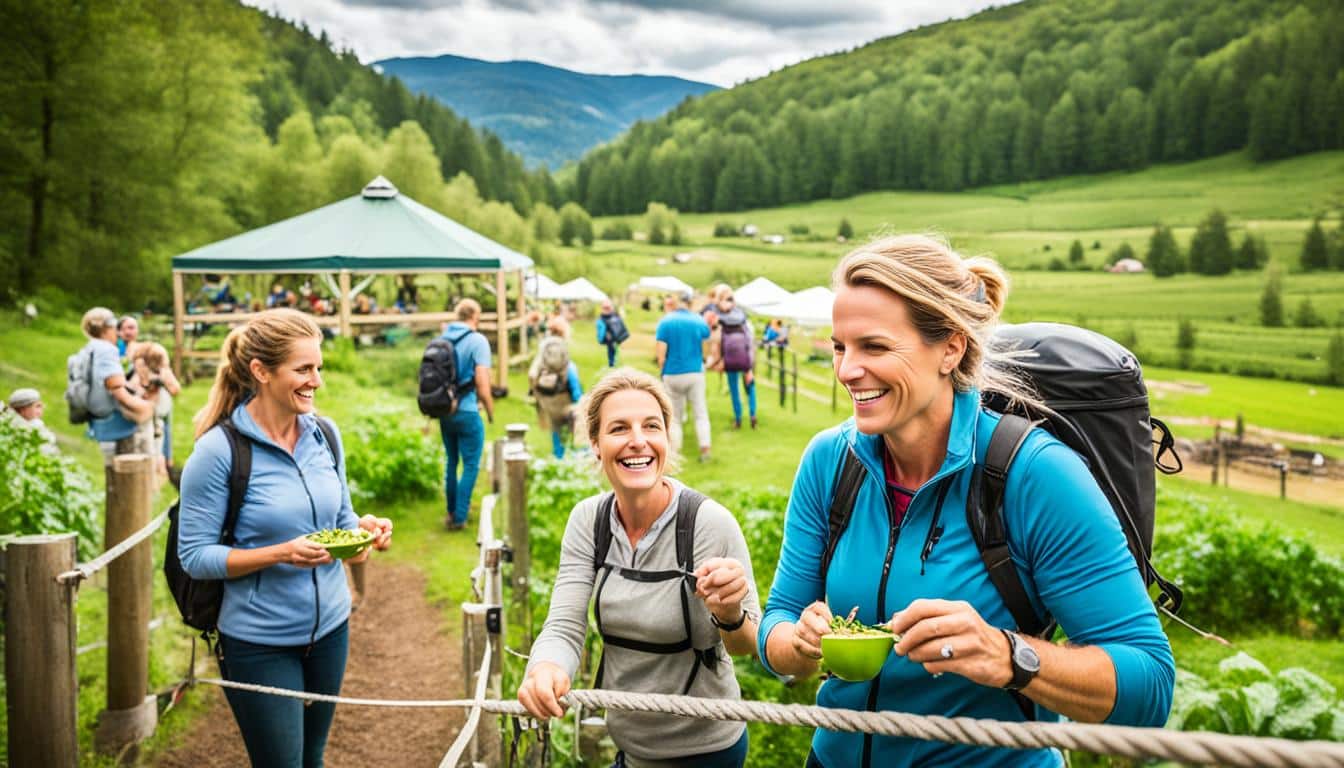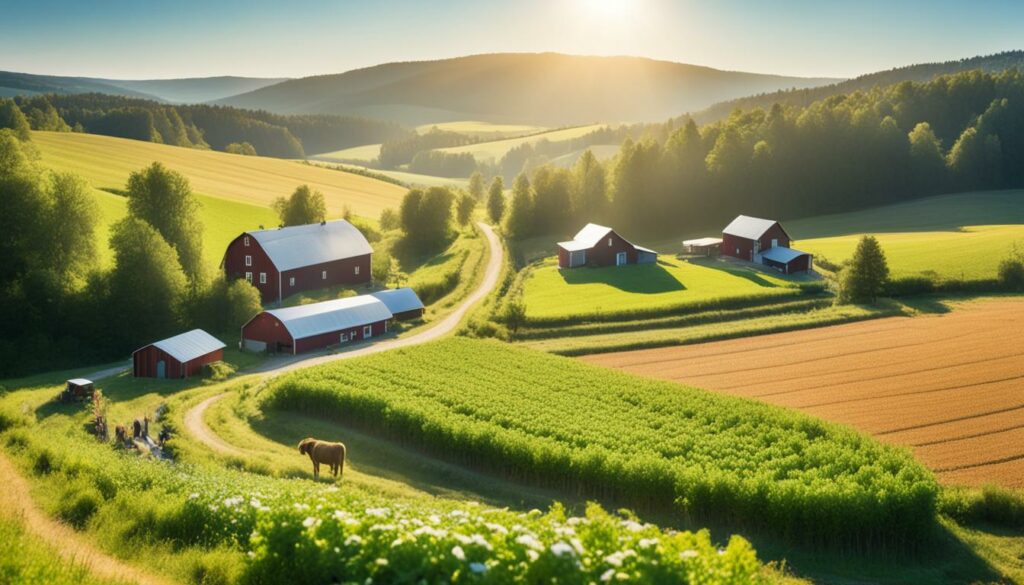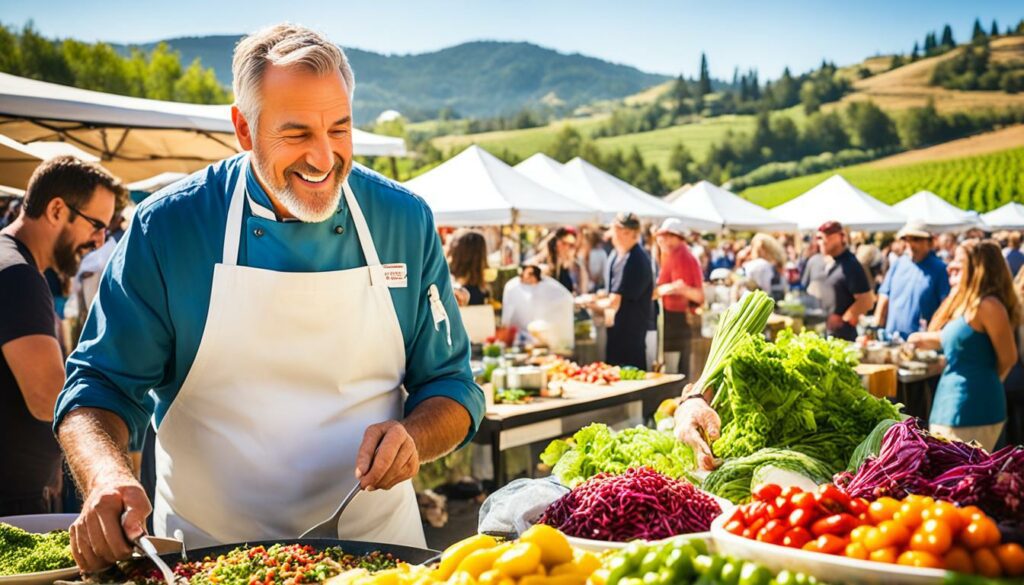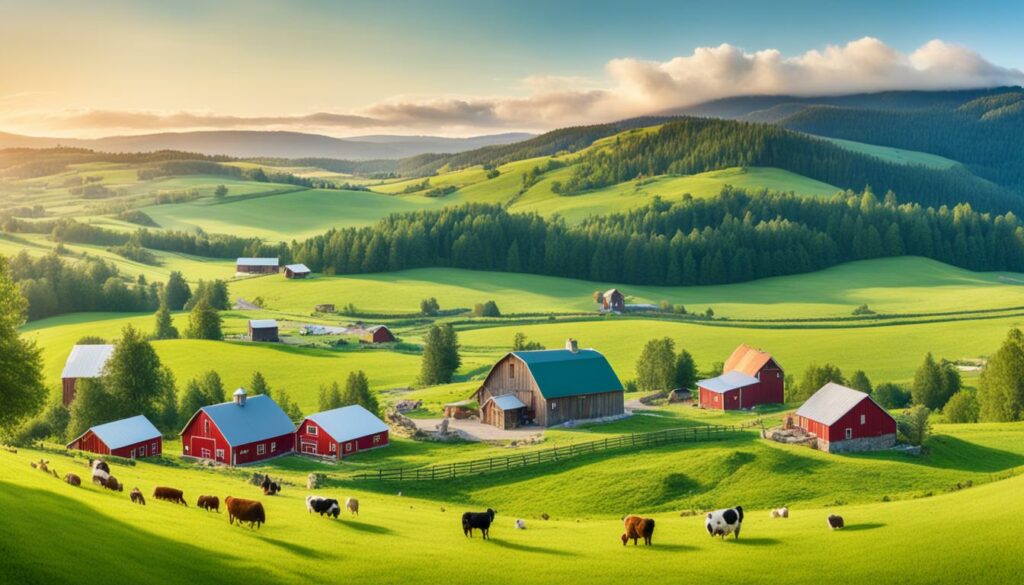Menu

Did you know Georgia’s rural counties saw a big 24.7% more demand for places to stay in 2022? This huge jump shows how much the agritourism field is growing. People are looking for hands-on farm experiences and ways to support the environment. This trend will only get stronger next year.
Georgia has been doing well in agritourism. It has seen more people visiting rural areas and spending money. These signs are not only good locally but also show what might happen across the country. With 4.3% more trips expected in the U.S. in 2024, both work and fun travel will leave a big mark on agritourism.
The Georgia Ag Forecast talks about how agritourism can change things for the better. It points out that it can help bring life back to the economy and teach people about farming. As we head into 2024, it looks like agritourism will keep growing. This growth will be powered by a focus on the planet and giving people real farm experiences.
Farm-to-table experiences are becoming very popular. They are a key part of 2024’s agritourism trends. People love them because they get to eat at farms and join in on the harvest. This is good for making consumers feel closer to their food’s origin. It also helps local economies grow.
Farm-to-table experiences are all about linking people with the food they eat. Visitors get to see how food is grown and harvested. This trend teaches them about sustainable farming and strengthens their bond with local food creators. That’s why the desire for real local food tourism is growing.
Places like Floyd, Hall, Gilmer, and Cherokee counties value farm-to-table experiences. They have fully embraced agritourism, which has boosted their income. Tourists enjoy a range of activities, from staying on farms to eating freshly cooked farm meals. These spots show how countryside areas can become lively places for agritourism. They also highlight the strong economic impact of agritourism.
Agritourism brings in over $949 million every year in the US. It creates jobs in rural areas, from working in restaurants to managing stays. It also helps farmers make more money by selling direct, teaching, and offering stays. This boosts local economies by upping food demand, which is expected to rise by 13.7% in rural areas according to the Georgia Ag Forecast.
The future of farm-to-table experiences is very promising. It will help the economy and bring producers and consumers closer. Taking part in these trends helps local farmers and offers people unique and learning-filled experiences.
In 2024, sustainable farming is key in agritourism. It balances nature and attracts visitors. These methods are vital for the earth and meet what people want today. They are essential in agritourism now.

Sustainable farming is crucial for our planet. It keeps farmland healthy and diverse, lowering the harm from farming. Experts at the Second World Congress on Agritourism in 2024 will talk about why this is key in tourism.
Many farms are leading in sustainable methods. They show success in both farming and being green. A good example is regenerative agritourism. It balances nature and visitor’s enjoyment well. Such ideas are not only popular but also make money.
Consumer want for green practices is growing fast. In Georgia, farm tourism income tripled, showing people prefer these options. This move highlights a great opportunity for eco-friendly agritourism. People are looking for places that match their eco values.
At the Second World Congress on Agritourism in 2024, experts predict continued success for green agritourism. These predictions are based on the market’s love for sustainable and fun activities.
There’s also a buzz around agritourism as a profitable business. But, it calls for a smart balance between farming and visitors. Plus, there’s a push for laws to keep farming practices green everywhere.
Technology has changed agritourism a lot. Smart farming and using gadgets has made things more smooth. It also makes visiting farms more fun for people.
Smart farming is key in making agritourism better. It uses IoT devices and data to use resources better. And it makes crops grow more, making visitors happy.
It’s part of a big trend. Global agritourism may be worth US$ 176.6 billion by 2032. This means it’s growing fast, at 11.45% every year.
Booking online has changed how people visit farms. Now, it’s easy to book spots on a farm any time. This makes it easier for farms to get visitors, helping the industry grow.
More than 20% of farm activities, like picking fruit or visiting wineries, use these sites. They reach more people this way. This shows how traditional farms are using modern tech to stay ahead.
GPS and remote sensors are making farms smarter. They help farms watch and take care of crops very closely. This impresses visitors and teaches them about new farming methods.
In general, using new technology in farming makes visitors’ trips better. It mixes science with fun farm visits.
| Year | Market Size (US$ Billion) |
|---|---|
| 2023 | 65.6 |
| 2032 (Forecast) | 176.6 |
Rural eco-tourism is growing quickly. This is because people want to travel sustainably. For example, in Georgia, the demand for rural stays went up by 24.7% in 2022. People are choosing eco-friendly places for their holidays to enjoy real nature.

To do well, rural eco-tourism follows green ways. This means farming and using resources wisely to protect the environment. In Georgia, visits to its state parks just grew by 1% in 2022. This shows more people are looking for eco-friendly adventures.
Beautiful areas with a strong farming past are becoming top eco-tourism spots. Georgia’s Gilmer, Fulton, Hall, Henry, and White counties have many places where visitors can pick their own food or taste environmentally friendly wines. These places help their local communities a lot.
More and more people are spending on eco-tourism. From 2018 to 2021, this spending grew by 28% to $1.08 billion. By 2024, trips in the U.S. are predicted to rise by 4.3%. This is a sign that the demand for sustainable travel will keep going up.
| Metric | Increase |
|---|---|
| Gross Demand for Accommodations (2022) | 24.7% |
| Gross Demand for Food (2022) | 13.7% |
| Visitation to State Parks (2022) | 1% |
| Agritourism Revenues (2018-2021) | 28% |
In 2024, agritourism will see big changes. These will come from new tech, green methods, and better guest experiences. Last year, it was worth US$ 65.6 billion. By 2032, it’s predicted to hit US$ 176.6 billion. This shows it’s growing fast, at an 11.45% rate each year.
Main activities driving this growth include selling on the farm, outdoor fun, fun on the farm, learning trips and places to stay. With more people wanting holidays that make a difference and are good for the planet, places where you can pick your own food and stay on farms will get more popular.
Big names in the market like Agrilys Voyages and Blackberry Farm LLC are making their services better. They’re using tech to make things easier and farming in eco-friendly ways. Booking online or through agents will still be key to attracting visitors from near and far.
North America and Europe will continue to lead, with over 60% of the market. But, Asia-Pacific, including China, Japan, and India, holds a lot of potential too.
| Year | Market Size (US$ Billion) | Growth Rate (%) |
|---|---|---|
| 2023 | 65.6 | – |
| 2025 | 100+ | – |
| 2032 | 176.6 | 11.45 |
I believe the future looks bright for agritourism in 2024 and on. More tech and a desire for meaningful eco-holidays will help the market grow. It’s an exciting time for everyone involved.
Agritourism is changing a lot, focusing more on agri-entertainment. It’s all about bringing fun and learning together in rural areas. This trend boosts the local economy and brings more people to the countryside.

There’s a lot to do in agri-entertainment, from fun festivals to hands-on workshops. Georgia has more than 430 spots for agritourism, like fruit picking and places making drinks. These make up almost a fifth of all Georgia’s agritourism, showing just how popular the mix of fun and education is.
Festivals are key in agri-entertainment, making visits memorable. They have things like pumpkin patches and tasty events, making the countryside come alive. And places to stay and eat see a big increase too, really helping the local economy.
People spent almost 15% more, reaching $32.7 billion, on trips to places like these in 2022. This shows agri-entertainment is gaining more fans. By mixing in cultural learning and fun, these places continue to grow in popularity.
Agricultural heritage preservation is very important in agritourism. It helps us take a step back in time. But it also leads to better economics and culture. By showing how people used to farm and live in the countryside, agritourism teaches us a lot. It makes us really understand and love the history of farming.
Historical agritourism is key to saving our farming past. It lets visitors see and learn from the past directly. In 2017, around 28,575 farms in the U.S. welcomed visitors. They made about $949 million from tourism. This joining of tourism and history helps keep old farming ways alive for future generations.
There are many benefits for the community in rural tourism. It boosts the local economy and makes people proud of their area. When locals get involved, efforts to save agricultural history are much stronger. In Georgia, places like Gilmer and Hall have seen their economies and culture get better from agritourism. Plus, places where tourists spend money get to save on taxes. This proves that tourism can really help communities.
Great examples of saving farming history are programmes like the Global Important Agricultural Heritage Systems (GIAHS). It has helped change farming in five countries for the better. The programme in Japan’s Noto Peninsula, for instance, has made farmers earn more. In China’s Aohan area, after getting GIAHS’ attention, sales went up a lot. This shows that preserving farming history can also be good for business.
These examples show how important it is to save our farming past through agritourism. As we get closer to 2024, agritourism’s role in keeping our farming legacy safe and bringing big economic and cultural gains is clearer than ever.
Culinary tourism brings people closer to local cultures through wine tours, culinary experiences, and workshops. It helps travellers connect with where their food comes from. In Georgia, there’s a big interest in winery tours and cooking classes. This shows how food and travel work together to enrich our experiences.

More and more people are interested in wine tours in Georgia. This is partly because Georgia’s wine business is growing and people love farm-to-table meals. They can visit vineyards, taste wines, and eat fresh meals at beautiful places. This trend matches a 24.7% increase in wanting to stay in the countryside. More people are after a full sensory food and drink experience when they travel.
Visitors can enjoy cooking workshops to learn local cuisines in Georgia. These experiences have become very popular, with a 13.7% rise in food demand in Georgia’s rural areas. These workshops provide visitors with a chance to taste traditional foods. Also, it helps local farmers by recommending their produce for the classes.
Culinary tourism is a great way to learn about new cultures. Tourists get to understand how locals live and work, mainly through wine tours and cooking classes. This not only makes their trip more enriching but also helps keep local customs alive. And the 14.9% increase in visitor spending shows how important food tourism is for both economy and culture.
Agritourism is growing fast, with pick-your-own farms leading the way. These farms let visitors pick fruits and vegetables straight from the land. It’s not only fun but also good for the farm’s money side.
Georgia is always ready for pick-your-own fun, from spring to autumn. Strawberries start the season, followed by blueberries and peaches. Apples and pumpkins are the stars of the fall. This flow of visitors helps farm incomes all year long.
Pick-your-own farms offer more than just picking. They host tours, let people taste fresh food, and serve meals from their produce. In 2023, these spots, along with wineries and more, made up a big part of Georgia’s visitor spots. This mix of activities keeps visitors coming back and helps the area’s businesses.
By letting visitors pick their own, farms open up new ways to make money. In Georgia, there are over 430 agritourism places. In Georgia, the money from agritourism jumped by 28% from 2018 to 2021, reaching over $1 billion. This industry is a key part of farms earning more and boosting local areas.
| Year | Total Agritourism Revenue (in millions) | Percentage Growth |
|---|---|---|
| 2018 | 989 | – |
| 2021 | 1080 | 28% |
Farm stay vacations are becoming more popular because people want to travel and live sustainably. They offer a close look at rural life. This lets visitors relax, learn, and have fun on the farm.

On a farm stay, guests join in with the daily tasks on the farm. They might help milk cows or pick fruit. This helps them learn and enjoy the farming life. Besides, many farms offer wellness activities like yoga and spa services, which are popular with those seeking relaxation.
There are many benefits of staying on a farm. Tourists can take a break from city life and find peace in nature. A study in South Korea showed that visits to farms can make people happier.
For farmers, these visits bring in money. This helps them earn more and supports their local community.
Great farm stay locations can be found all over the world. In the U.S., places like Beltane Ranch and Southall Farm & Inn offer a mix of old and new in a scenic setting. They also provide fun activities, like wine tasting.
Abroad, destinations like Ebbio in Tuscany and Babylonstoren in South Africa stand out. They offer unique experiences, from riding horses to hunting for truffles. Visitors can relax and have adventures here.
Here’s a look at some famous farm stay spots:
| Location | Activities | Amenities |
|---|---|---|
| Beltane Ranch, USA | Vineyard Tours, Gardening | Spa, Fine Dining |
| Beach Plum Farm, USA | Beekeeping, Falconry | Modern Spa |
| Herdade da Malhadinha Nova, Portugal | Horseback Riding, Cooking Classes | Wine Tasting, Spa Treatments |
| Babylonstoren, South Africa | Truffle Hunting, Nature Walks | Luxurious Spa |
Farm stays will be even more popular by 2024. They offer a sustainable and health-conscious way to travel. This trend means both travellers and farmers can benefit in the future.
Looking to 2024, regenerative agriculture plays a big role in agritourism’s future. It focuses on saving ecosystems and using farming methods that last. This is key in a time when many care about the environment.
This type of farming helps the soil, brings more plants and animals, and keeps farms running for the long haul. It’s not just good for nature. It also pulls in visitors who want their trips to support these green activities. So, farms that follow regenerative farming are getting more popular as travel spots.
Regenerative farming is all about managing the land wisely. It involves using less machinery to upset the soil less, growing different crops each year, and adding animals to the land like in nature. These methods build up the soil and make it better at keeping water and supporting plant growth. As a result, farms can keep producing food without using a lot of chemicals.
There are many examples of farms worldwide that show the benefits of regenerative farming. They not only grow more but also bring in more tourists. For instance, a farm in Georgia has proven that it’s possible to mix green farming and fun tourist activities to make a big difference.
At the 2024 Agritourism World Congress, people will talk about how this farming approach can improve tourism. They’ll share how it’s helping and give examples from farms and tourist spots that are already making this work. This event will show the good effects of these green farming methods and how they can fit with tourism.
The journey of agritourism is growing mainly on a regional level. This gives lots of chances for both big names like Agrilys Voyages and new players. They are making the most of this regional agritourism boom.

New places in agritourism are growing, fuelled by a high demand from tourists worldwide. In 2023, the market size was US$ 65.6 billion. Experts expect it to reach US$ 176.6 billion by 2032, with an 11.45% yearly growth.
Georgia, for example, saw a big jump in people wanting to stay in the countryside and spend in restaurants. This growth shows others states and countries can also do well. Places that offer picking farms and fun on the farm are significant in this story.
Small farms have a good chance in the growing agritourism trend. They can provide unique, personal experiences that big farms find hard to match. More U.S. travellers are expected to visit farms, giving small farms a chance to shine.
Look at Georgia with its over 430 farm attractions. It shows small farms can also do well. They can sell directly from the farm and offer educational tours, making money in new ways. This wins them a place in the fast-growing experiential tourism market.
The scene is getting competitive, with companies like Bay Farm Tours showing the way. Working together and being creative help small farms stand out. They can become a big hit locally and abroad, thanks to such partnerships.
In the end, it’s about the combined growth on a regional level, the rise of new markets, and the appeal of small farm experiences. These are all building blocks for a bright future in this field.
Agritourism is evolving, bringing new challenges and opportunities. The World Congress on Agritourism is a key event. It talks about both the problems, like rules and how to do things, and how to market well.
To get more visitors and make money, good marketing is vital. Using the internet to show off your place is very important now. This means doing well on social media and in search results.
Understanding and following the rules in agritourism is crucial. This often means finding a good balance between your family, the farm work, and looking after visitors. The World Congress helps by offering ideas and chances to talk about these challenges.
New and smart ways to do agritourism are being found. For example, there are now farms that care a lot about the environment and how they treat visitors. They show a way which is better for nature and is still fun for people. The GAN helps by sharing the best ways for hosts to meet and talk with guests. This makes a friendly and helpful place.
To do well in agritourism, it’s key to follow the rules and market well. By being creative and finding new ways to do things, the sector can grow even when times change.
In 2024, agritourism shows strong growth and resilience. In three years, it could be worth USD 16604.37 million. Different types of agritourism appeal to people of all ages. This includes selling farm goods directly, learning experiences, and fun events.
New tech is improving visits and making farms more efficient. Eco-friendly efforts are also a big hit. The top agritourism spots are in North America, Europe, and Asia. China is expected to see big growth, thanks to its economy and more spending money.
The sector has adapted well after COVID-19. It’s seen changes like new trends and what customers want. Companies have had to be quick and smart to handle this. The sector is set to grow till 2031, being valued at USD 6841.17 million. With a strong tie to local communities and smart moves, agritourism will be key in the big tourism picture.
In 2024, key trends in agritourism are all about being green and real. They focus on eco-friendly and genuine travel. This includes doing farming in a way that helps the planet. Plus, it’s about making the countryside more fun and interesting for tourists.
Farm-to-table experiences do a lot of good for local areas. They bring money to the countryside and keep local farms going. Also, they help the environment with the way food is grown. Georgia, for example, saw more money being spent on food from the countryside. This shows how important these experiences are for local economies.
Sustainable farming covers several practices. These include rotating crops, farming without chemicals, and using natural energy. Farms that do this don’t just help the earth. They also appeal to visitors keen on nature-friendly and ethical holidays.
Technology is changing agritourism in big ways. It’s making farms smart and efficient. It’s also helping visitors plan their trips online. This makes countryside adventures easier and more appealing for many people.
Rural eco-tourism is all about being nice to the planet and promoting green ways of travelling. It’s becoming more popular because people want trips that are good for nature. These trips not only connect people with the earth but also help with saving it.
Agri-entertainment means fun farm events like festivals and workshops. These activities teach and entertain tourists. They also bring more money to the countryside, supporting local businesses and farms.
Keeping old farming ways alive in agritourism is good for many reasons. It teaches us about the past and makes people proud of their roots. It also helps rural areas make more money. And, it’s key to saving traditional farming and cultural practices.
Culinary tourism pairs lovely food with trips to the countryside. It includes wine tours and chances to cook and eat local dishes. This not only pleases the taste buds but also supports farm-based food makers.
Pick-your-own experiences let visitors harvest their own farm food. They’re popular as they offer a direct farm experience and fresh, local food. They also make extra income for farmers.
On a farm stay, tourists get deep into farm life. They help out, enjoy fresh food, and chill in the countryside. It’s an educational and relaxing trip that supports farmers.
Regenerative agriculture is all about making farms and the earth healthier. It fits perfectly with the eco-friendly way many tourists want to travel. It also pulls in visitors who care about the environment and ethical food production.
Small farms can offer unique rural experiences that visitors love. These can range from special tours to different kinds of places to stay. With more interest in the countryside, small farms have a big chance to get noticed and grow.
To draw in visitors, agritourism spots should use the internet and social media. They should show off what makes their farm visits special – like how they help the planet. Making the online experience fun and visual is also key.
Rules and laws about farm tourism can be tough to figure out. They cover everything from how a farm can be used for visitors to keeping everyone safe. It’s important for these farms to stay on top of the legal side to make their visitors’ trips smooth and worry-free.
Using tech for running the farm and for attracting visitors can solve a lot of issues. It makes the farm more efficient and makes planning a visit easier and more enjoyable. Teaming up with others in the area can also help create better, more complete experiences for visitors.